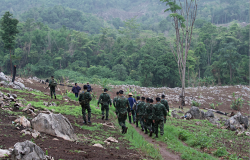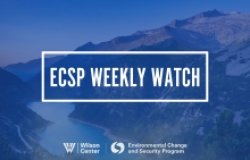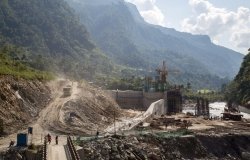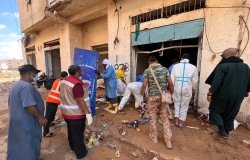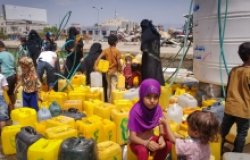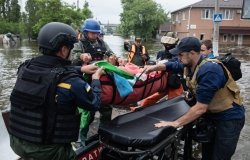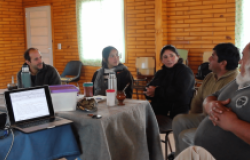Invest in Integrated Development, Say Leaders of East Africa Population-Health-Environment Network
MARCH 2009—Rwandan Projects Demonstrate Value of PHE Approach
Integrating family planning, health, and environmental conservation into single development projects is critical, agreed the 30 leaders of the East Africa Population-Health-Environment (PHE) Network, who gathered in Rwanda from February 23-27, 2009, to discuss ways to convince governments and donors to invest more in these holistic approaches. The workshop—sponsored by the Population Reference Bureau (PRB)—marked the group's first meeting since its founding in Addis Ababa, Ethiopia, in November 2007. At the Ethiopia conference, also sponsored by PRB, the Environmental Change and Security Program conducted a role-playing simulation designed to bring to life the connections between population growth, natural resource management, and development priorities.
Rwanda Needs Integrated Development, Say Experts, Officials
Rwanda's highest-in-Africa population density of 365 people per square kilometer leads to environmental degradation and poor human health, said Rwandan Minister of Natural Resources Stanislas Kamanzi, who officially launched the workshop. This fact compels Rwanda to take an integrated approach to development, he said: Rwanda's National Environment Policy and national development plan, Vision 2020, both recognize PHE links, and Rwanda is committed to implementing the recommendations of the First Inter-ministerial Conference on Health and Environment in Africa.
A new policy brief on Rwanda, presented by Jason Bremner, PHE program director at the Population Reference Bureau, makes a similar argument: "Continued improvement in the quality of life of Rwanda's citizens depends in large part on finding innovative and integrated solutions to complex population, health, and environment problems."
Translating Strong Results Into Informed Policies
Even the best program or most dramatic research findings will not be implemented unless they are communicated to policymakers in succinct, persuasive ways. Yet researchers often neglect to convey their results to decision-makers and donors, assuming they do not care or understand.
The second and third days of the meeting aimed to help the working groups from Rwanda, Uganda, Ethiopia, and Kenya develop strategies to bridge this research-to-policy gap. The groups brainstormed policy communications objectives—such as officially launching their country's PHE network—as well as concrete outcomes, such as convincing representatives from national government ministries to join the network.
Into the Field: Coffee and Tourism in Rwanda
Field visits to two projects in Rwanda dramatically illustrated the benefits and challenges of the PHE approach:
- The SPREAD project helps farmers produce higher-quality crops, particularly coffee. Better crops mean more income, since there isn't any more land to farm in Rwanda. The same workers who teach farmers to grow better coffee also deliver basic health and family planning messages and products.
- Destination Nyungwe Project is trying to transform Rwanda's Nyungwe National Park into a world-class tourism destination—and in process, improve the health, livelihoods, and environmental management of the neighboring communities. Nyungwe's survival depends on health and family planning, because high population growth—and the resulting demand for land—is one of the key threats to the park.
Into the Future
Next steps for the East Africa PHE Network include establishing a listserv dedicated to the East Africa PHE Network, reciprocal visits to field sites, and additional training in policy communications and PHE fundamentals. To sign up for the AFRICAPHE listserv, contact jbremner@prb.org.
Related Links
- Rachel Weisshaar (blog post): "East Africa Population-Health-Environment Conference Kicks Off in Kigali"
- Rachel Weisshaar (blog post): "East Africa Population-Health-Environment Conference Kicks Off in Kigali"
- Rachel Weisshaar (blog post): "East Africa Population-Health-Environment Conference Kicks Off in Kigali"
- Rachel Weisshaar (blog post): "East Africa Population-Health-Environment Conference Kicks Off in Kigali"
- Rachel Weisshaar (blog post): "East Africa Population-Health-Environment Conference Kicks Off in Kigali"
- Rachel Weisshaar (blog post): "East Africa Population-Health-Environment Conference Kicks Off in Kigali"
- Rachel Weisshaar (blog post): "East Africa Population-Health-Environment Conference Kicks Off in Kigali"
- Rachel Weisshaar (blog post): "East Africa Population-Health-Environment Conference Kicks Off in Kigali"
Related Program

Environmental Change and Security Program
The Environmental Change and Security Program (ECSP) explores the connections between environmental change, health, and population dynamics and their links to conflict, human insecurity, and foreign policy. Read more
